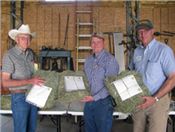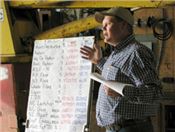Testing Tells Alfalfa's Worth
ASH GROVE, MO.
“Cows and horses think alfalfa looks like candy, smells like candy and tastes like candy,” says University of Missouri Extension livestock specialist Andrew McCorkill.
However, alfalfa’s proof is in the pudding. Not all hay that looks good is good hay. Not all good hay looks good. The only way to know is by testing samples to determine the nutritional value.
McCorkill spoke at a recent MU Extension alfalfa tour. MU Extension in Greene County and Mid-Missouri Bank sponsored the tour at the Rick and Justin Williams farm in Ash Grove.
Testing gives nutrient information needed to make supplement decisions. Hay testing is one of the cheapest and best investments a livestock producer can make, McCorkill says.
“Sometimes our forages are better than we think, but a lot of times they aren’t,” he says. Hay’s value cannot be measured simply by eye appeal. It is a case of “Pretty is as pretty does.”
Protein, energy and fiber content determine how our livestock perform, McCorkill says. Hay with high nutritional value helps dairy cows make more milk. Dairy producers can feed less grain to cows when hay has high nutritional value. Horse owners may choose alfalfa for its soft, leafy green stems favored by horses.
Alfalfa works as a good supplement for beef cows on mostly poor-quality fescue hay. Some producers use it as a creep feed for calves as well. “Alfalfa has an intrinsic value that is not explained by numbers alone. Livestock just perform on it if it’s fed properly,” he says.
“Less mature cuttings tend to be more digestible,” McCorkill says. Livestock favor the early tender cuttings over later-season stems that are more brittle, tougher and contain more indigestible fiber.
Accurate results come from a good sampling process, McCorkill says. Always use a hay probe to take a core sample. Do not take random flakes or hand-grabbed samples.
Take a sample from the round side of a round bale or the end of a square bale between ties. Probe between 10 and 20 bales and get a sample that weighs about a pound. Sort hay into lots by hay type. Do not mix cuttings, fields or types.
To learn more, look under “Livestock, poultry and forages” at extension.missouri.edu/webster/agriculture.aspx.
Hay tests cost about $20 each at certified labs throughout the state. You can find information on how to read results at extension.missouri.edu/aginfocus/forage-testing.aspx.
Many MU Extension offices have a hay sampling probe that can be used free of charge, McCorkill says. Find information on hay sampling at crops.missouri.edu/forage. ∆

(Above) From left, MU Extension specialists Eldon Cole, Andrew McCorkill and Tim Schnakenberg show hay samples at a recent alfalfa tour.
Not all good hay looks good. Not all hay that looks good is good hay. Testing tells.
(Below) MU Extension livestock specialist Andrew McCorkill explains the importance of hay testing at a recent alfalfa tour in Ash Grove, Mo.
Photo credits: Photo by Linda Geist
